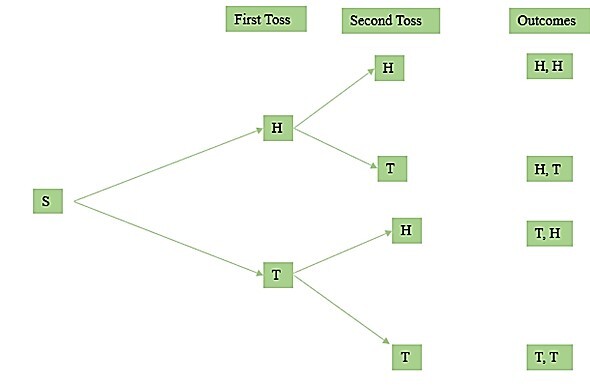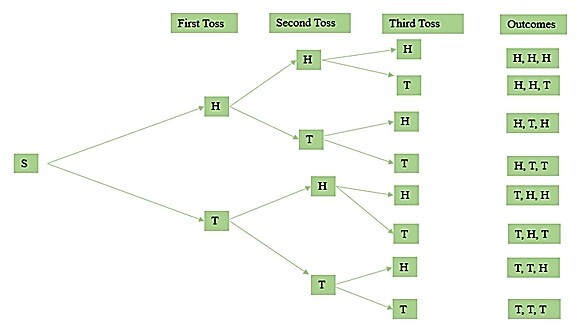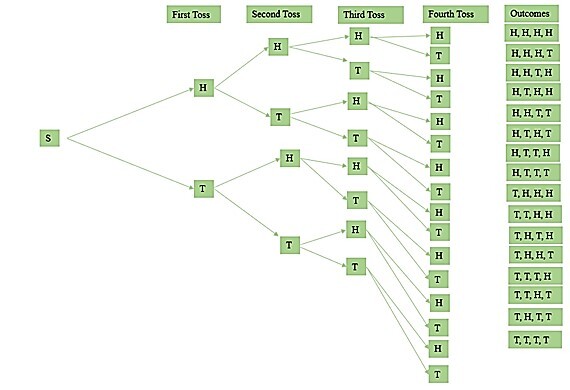
 Data Structure
Data Structure Networking
Networking RDBMS
RDBMS Operating System
Operating System Java
Java MS Excel
MS Excel iOS
iOS HTML
HTML CSS
CSS Android
Android Python
Python C Programming
C Programming C++
C++ C#
C# MongoDB
MongoDB MySQL
MySQL Javascript
Javascript PHP
PHP
- Selected Reading
- UPSC IAS Exams Notes
- Developer's Best Practices
- Questions and Answers
- Effective Resume Writing
- HR Interview Questions
- Computer Glossary
- Who is Who
Sample Space
Introduction
In daily life, we encounter various activities that have multiple outcomes. Although we cannot predict the exact outcome, we can estimate all possible outcomes of that event or activity. In this tutorial, we will discuss the sample space, some special events, and their possible outcomes with solved examples.
Sample Space
The sample space, a concept of probability theory, is the collection of all the possible outcomes of a random event or experiment. The sample space is abbreviated by the set notation and is more usually represented by S. Moreover, it can also be represented by U (universal set) or ?. A sample space contains numbers, words, letters, or symbols.
Sample Space of n Coins Tossed Simultaneously, n = 2, 3, 4, 5
A coin has two sides, i.e., head and tail. Let's denote head as "H" and tail as "T".
Two coins tossed simultaneously
The possible outcomes in tossing two coins simultaneously are as follows $\mathrm{S\:=\:\lbrace\:(H\:,\:H)\:,\:(H\:,\:T)\:,\:(T\:,\:H)\:,\:(T\:,\:T)\:\rbrace\:}$
$\mathrm{Number\:of\:outcomes\:=\:4(2^{2})\:(as\:shown\:in\:the\:figure)}$.

Three coins tossed simultaneously
The possible outcomes in tossing three coins simultaneously are as follows.
$\mathrm{S\:=\:\lbrace\:(H\:,\:H\:,\:H)\:,\:(H\:,\:H\:,\:T)\:,\:(H\:,\:T\:,\:H)\:,\:(H\:,\:T\:,\:T)\:,\:(T\:,\:H\:,\:H)\:,\:(T\:,\:H\:,\:T)\:,\:(T\:,\:T\:,\:H)\:,\:(T\:,\:T\:,\:T)\rbrace}$
$\mathrm{Number\:of\:outcomes\:=\:8(2^{3})}$

Four coins tossed simultaneously
The possible outcomes in tossing four coins simultaneously are as follows.
$\mathrm{(H\:,\:H\:,\:H\:,\:H)\:,\:(H\:,\:H\:,\:H\:,\:T)\:,\:(H\:,\:H\:,\:T\:,\:H),(H\:,\:H\:,\:T\:,\:T)\:,\:(H\:,\:T\:,\:H\:,\:H)\:,\:(H\:,\:T\:,\:H\:,\:T)\:,\:(H\:,\:T\:,\:T\:,\:T)\:,\:(H\:,\:H\:,\:T\:,\:T)\:,\:(T\:,\:H\:,\:H\:,\:H)\:,\:(T\:,\:T\:,\:H\:,\:H)\:,\:(T\:,\:H\:,\:T\:,\:H)\:,\:(T\:,\:H\:,\:H\:,\:T)\:,\:(T\:,\:T\:,\:T\:,\:H)\:,\:(T\:,\:T\:,\:H\:,\:T)\:,\:(T\:,\:H\:,\:T\:,\:T)\:,\:(T\:,\:T\:,\:T\:,\:T)}$
$\mathrm{Number\:of\:outcomes\:=\:16(2^{4})}$

Five coins tossed simultaneously
The possible outcomes in tossing five coins simultaneously are as follows.
$\mathrm{\lbrace\:(H\:,\:H\:,\:H\:,\:H\:,\:H)\:,\:(H\:,\:H\:,\:H\:,\:H\:,\:T)\:,\:(H\:,\:H\:,\:H\:,\:T\:,\:T)\:,\:(H\:,\:H\:,\:T\:,\:T\:,\:T)\:,\:(H\:,\:T\:,\:T\:,\:T\:,\:T)\:,\:(T\:,\:T\:,\:T\:,\:T\:,\:T)\:,\:(T\:,\:T\:,\:T\:,\:T\:,\:H)\:,\:(T\:,\:T\:,\:T\:,\:H\:,\:H)\:,\:(T\:,\:T\:,\:H\:,\:H\:,\:H)\:,\:(T\:,\:H\:,\:H\:,\:H)\:,\:(H\:,\:T\:,\:H\:,\:T\:,\:H)\:,\:(T\:,\:H\:,\:T\:,\:H\:,\:T)\:,\:(H\:,\:H\:,\:T\:,\:H\:,\:H)\:,\:(T\:,\:T\:,\:H\:,\:T\:,\:T)\:,\:(H\:,\:T\:,\:T\:,\:H\:,\:T)\:,\:(T\:,\:H\:,\:H\:,\:T\:,\:H)\:,\:(T\:,\:H\:,\:H\:,\:H\:,\:T)\:,\:(H\:,\:T\:,\:T\:,\:T\:,\:H)\:,\:(T\:,\:H\:,\:H\:,\:T\:,\:T)\:,\:(H\:,\:T\:,\:T\:,\:H\:,\:H)\:,\:(H\:,\:H\:,\:T\:,\:T\:,\:H)\:,\:(T\:,\:T\:,\:H\:,\:H\:,\:T)\:,\:(T\:,\:T\:,\:H\:,\:T\:,\:H)\:,\:(H\:,\:H\:,\:T\:,\:H\:,\:T)\:,\:(H\:,\:T\:,\:H\:,\:T\:,\:T)\:,\:(T\:,\:H\:,\:T\:,\:H\:,\:H)\:,\:(T\:,\:H\:,\:T\:,\:H\:,\:H)\:,\:(T\:,\:H\:,\:T\:,\:T\:,\:H)\:,\:(H\:,\:T\:,\:H\:,\:H\:,\:T)\:,\:(H\:,\:T\:,\:H\:,\:T\:,\:T)\:,\:(T\:,\:H\:,\:T\:,\:H\:,\:H)\:,\:(H\:,\:H\:,\:H\:,\:T\:,\:H)\:,\:(T, T\:,\:T\:,\:H\:,\:T)\:\rbrace }$
$\mathrm{Number\:of\:outcome\:=\:32(2^{5})}$
Sample Space of 2 Die Thrown Simultaneously
If two die thrown simultaneously, we will get 36 outcomes as follows
$\mathrm{S\:=\:\lbrace\:(1\:,\:1)\:,\:(1\:,\:2)\:,\:(1\:,\:3)\:,\:(1\:,\:4)\:,\:(1\:,\:5)\:,\:(1\:,\:6)\:,\:(2\:,\:1)\:,\:(2\:,\:2)\:,\:(2\:,\:3)\:,\:(2\:,\:4)\:,\:(2\:,\:5)\:,\:(2\:,\:6)\:,\:(3\:,\:1)\:,\:(3\:,\:2)\:,\:(3\:,\:3)\:,\:(3\:,\:4)\:,\:(3\:,\:5)\:,\:(3\:,\:6)\:,\:(4\:,\:1)\:,\:(4, 2)\:,\:(4\:,\:3)\:,\:(4\:,\:4)\:,\:(4\:,\:5)\:,\:(4\:,\:6)\:,\:(5,1)\:,\:(5\:,\:2)\:,\:(5\:,\:3)\:,\:(5\:,\:4)\:,\:(5\:,\:5)\:,\:(5\:,\:6)\:,\:(6\:,\:1)\:,\:(6\:,\:2)\:,\:(6\:,\:3)\:,\:(6\:,\:4)\:,\:(6\:,\:5)\:,\:(6\:,\:6)\rbrace\:.}$
Sample Space of 1, 2, 3 Coins and 1 Die Thrown Simultaneously
Let's consider an event of tossing one coin and one die. The possible outcomes will be
$\mathrm{S\:=\:\lbrace\:(H\:,\:1)\:,\:(2\:,\:H)\:,\:(3\:,\:H)\:,\:(4\:,\:H)\:,\:(5\:,\:H)\:,\:(6\:,\:H)\:,\:(1\:,\:T)\:,\:(2\:,\:T)\:,\:(3\:,\:T)\:,\:(4\:,\:T)\:,\:(5\:,\:T)\:,\:(6, H)\:\rbrace\:.}$
$\mathrm{The\:total\:number\:of\:outcome\:=\:2\:\times\:6\:=\:12}$
Let's consider an event of tossing two coins and one die. The possible outcomes will be
$\mathrm{S\:=\:\lbrace\:(H\:,\:H\:,\:1)\:,\:(H\:,\:H\:,\:2)\:,\:(H\:,\:H\:,\:3)\:,\:(H\:,\:H\:,\:4)\:,\:(H\:,\:H\:,\:5)\:,\:(H\:,\:H\:,\:6)\:,\:(T\:,\:T\:,\:1)\:,\:(T\:,\:T\:,\:2)\:,\:(T\:,\:T\:,\:3)\:,\:(T\:,\:T\:,\:4)\:,\:(T\:,\:T\:,\:5)\:,\:(T\:,\:T\:,\:6)\:,\:(T\:,\:H\:,\:1)\:,\:(T\:,\:H\:,\:2)\:,\:(T\:,\:H\:,\:3)\:,\:(T\:,\:H\:,\:4)\:,\:(T\:,\:H\:,\:5)\:,\:(T\:,\:H\:,\:6)\:,\:(H\:,\:T\:,\:1)\:,\:(H\:,\:T\:,\:2)\:,\:(H\:,\:T\:,\:3)\:,\:(H\:,\:T\:,\:4)\:,\:(H\:,\:T\:,\:5)\:,\:(H\:,\:T\:,\:6)\rbrace\:.}$
$\mathrm{The\:total\:number\:of\:outcomes\:=\:2\times\:2\times\:6\:=\:24}$
Let's consider an event of tossing three coins and one die
$\mathrm{The\:total\:number\:of\:outcomes\:=\:2\times\:2\times\:2\times\:6\:=\:48}$
$\mathrm{S\:=\:\lbrace\:(H\:,\:H\:,\:H\:,\:1)\:,\:(H\:,\:H\:,\:H\:,\:2)\:,\:(H\:,\:H\:,\:H\:,\:3)\:,\:(H\:,\:H\:,\:H\:,\:4)\:,\:(H\:,\:H\:,\:H\:,\:5)\:,\:(H\:,\:H\:,\:H\:,\:6)\:,\:(H\:,\:H\:,\:T\:,\:1)\:,\:(H\:,\:H\:,\:T\:,\:2)\:,\:(H\:,\:H\:,\:T\:,\:3)\:,\:(H\:,\:H\:,\:T\:,\:4)\:,\:(H\:,\:H\:,\:T\:,\:5)\:,\:(H\:,\:H\:,\:T\:,\:6)\:,\:(H\:,\:T\:,\:H\:,\:1)\:,\:(H\:,\:T\:,\:H\:,\:2)\:,\:(H\:,\:T\:,\:H\:,\:3)\:,\:(H\:,\:T\:,\:H\:,\:4)\:,\:(H\:,\:T\:,\:H\:,\:5)\:,\:(H\:,\:T\:,\:H\:,\:6)\:,\:(H\:,\:T\:,\:T\:,\:1)\:,\:(H\:,\:T\:,\:T\:,\:2)\:,\:(H\:,\:T\:,\:T\:,\:3)\:,\:(H\:,\:T\:,\:T\:,\:4)\:,\:(H\:,\:T\:,\:T\:,\:5)\:,\:(H\:,\:H\:,\:T\:,\:6)\:,\:(T\:,\:H\:,\:H\:,\:1)\:,\:(T\:,\:H\:,\:H\:,\:2)\:,\:(T\:,\:H\:,\:H\:,\:3)\:,\:(T\:,\:H\:,\:H\:,\:4)\:,\:(T\:,\:H\:,\:H\:,\:5)\:,\:(T\:,\:H\:,\:H\:,\:6)\:,\:(T\:,\:H\:,\:T\:,\:1)\:,\:(T\:,\:H\:,\:T\:,\:2)\:,\:(T\:,\:H\:,\:T\:,\:3)\:,\:(T\:,\:H\:,\:T\:,\:4)\:,\:(T\:,\:H\:,\:T\:,\:5)\:,\:(T\:,\:H\:,\:T\:,\:6)\:,\:(T\:,\:T\:,\:H\:,\:1)\:,\:(T\:,\:T\:,\:H\:,\:2)\:,\:(T\:,\:T\:,\:H\:,\:3)\:,\:(T\:,\:T\:,\:H\:,\:4)\:,\:(T\:,\:T\:,\:H\:,\:5)\:,\:(T\:,\:T\:,\:H\:,\:6)\:,\:(T\:,\:T\:,\:T\:,\:1)\:,\:(T\:,\:T\:,\:T\:,\:2)\:,\:(T\:,\:T\:,\:T\:,\:3)\:,\:(T\:,\:T\:,\:T\:,\:4)\:,\:(T\:,\:T\:,\:T\:,\:5)\:,\:(T\:,\:T\:,\:T\:,\:6)\:\rbrace\:}$
Events
Events are defined as the subset of the sample space. Events are the specific event that occurs in a trial. For example, getting head in a flip of a coin is an example of an event.
$\mathrm{Event\:=\:E\:=\:\lbrace\:\:\rbrace\:}$
$\mathrm{S\:=\:\lbrace\:all\:possible\:outcomes\:\rbrace\:}$
Probability
In mathematics, the probability is defined as a numerical description of the likelihood of the occurrence of an event. In other words, it tells how likely the event will occur. The numeric value of probability varies between 0 and 1. The higher the value of probability, the higher the possibility of the occurrence of the event. The concept of probability is extensively used in science, finance, artificial intelligence, game theory, computer science, etc.
Solved Examples
Example 1
What is the probability of the head and tail when a coin is flipped?
Solution
$\mathrm{The\:probability\:of\:heas\:=\:\frac{1}{2}}$
$\mathrm{The\:probability\:of\:tail\:=\:\frac{1}{2}}$
Example 2
What is the sample space for the given interval: [1, 12]?
Solution
As the interval is a closed interval, the numbers 1 and 12 are also included in the sample space.
Hence, the sample space is $\mathrm{=\:S\:=\:\lbrace\:1\:,\:2\:,\:3\:,\:4\:,\:5\:,\:6\:,\:7\:,\:8\:,\:9\:,\:10\:,\:11\:,\:12\:\rbrace\:}$
Conclusion
The present article gives a brief idea about the sample space. The basic difference between event and sample space is described, along with various examples. In addition, the sample spaces for various well-known events have been determined. In conclusion, the present article may be useful for understanding the basic concept of sample space.
FAQs
1. What is the number of outcomes if a die is thrown thrice?
If a die is thrown thrice, the number of outcomes is $\mathrm{=\:6\:\times\:6\:\times\:6\:=\:216}$.
2. What are the applications of probability?
The concept of probability is extensively used in science, finance, artificial intelligence, game theory, computer science, etc.
3. What are the possible ways to represent the sample space?
The sample space can be represented in three ways as
Tabular form
List form
Tree diagram
4. Can the value of probability be greater than one?
No, since the maximum value of the probability is 1. hence, it is always less than one.
5. What will be the number of outcomes if a coin is tossed 6 times?
If a coin is tossed 6 times, the number of outcomes is $\mathrm{2^{6}\:=\:64}$.

